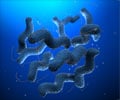Symptoms of Neurocysticercosis / Cysticercosis of Brain / Pork Tapeworm
In many patients the cysts remain asymptomatic. When the cyst starts to degenerate that symptoms appear.
In India 'Solitary Cystic Granuloma' or (SCG) is most commonly encountered, while in other parts of the world multiple cysts are frequently seen.
Neurocysticercosis is a complication of the pork tapeworm infection. In many patients the cysts remain asymptomatic. The viable cyst generally does not cause any symptoms; it is only when the cyst starts to degenerate that symptoms appear. The tapeworm when in the intestinal tract can give rise to several symptoms:
Some of the common ones are-


- Accumulation of fluid or Hydrocephalus may result from obstruction to the flow of the lubricating fluid of the brain (cerebrospinal fluid) by the cysticerci.
However, amongst rare incidences (less than 20% cases), the following abnormal manifestations occur-
- Cognitive decline
- Dysarthria
- Extraocular movement palsy or paresis
- Hemiparesis or hemiplegia, which may be related to stroke, or Todd paralysis
- Hemisensory loss
- Movement disorders
- Hyper/hyporeflexia
- Gait disturbances
When these infection develop in the base of the brain or in the subarachnoid space they may cause chronic meningitis or arachnoiditis communicating hydrocephalus or strokes.
The clinical manifestations of pork tapeworm infection or cysticercosis depends on the number and the location of cysticerci as well as the extent of inflammation. As it has a long incubation period the symptoms do not appear until many years after infection with the tapeworm.










